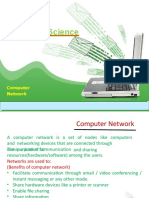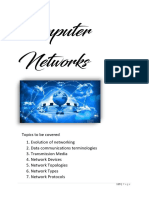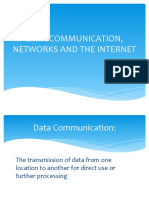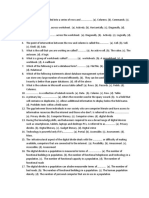0 ratings0% found this document useful (0 votes)
5 viewsComputer Network Class XII
Uploaded by
ayush5072007Copyright
© © All Rights Reserved
Available Formats
Download as PDF, TXT or read online on Scribd
0 ratings0% found this document useful (0 votes)
5 viewsComputer Network Class XII
Uploaded by
ayush5072007Copyright
© © All Rights Reserved
Available Formats
Download as PDF, TXT or read online on Scribd
You are on page 1/ 49
Computer Network
A computer network is a collection of interconnected devices,
such as computers and servers, that share resources and
information. These devices communicate using common
protocols to enable the transmission and exchange of data.
ARPANET
• ARPANET is defined as the first computer network that
It was developed by the United States Department of
Defense’s Advanced Research Projects Agency (ARPA)
in the late 1960s and early 1970s to connect computers
and researchers at various universities and research
institutions.
NSFNET (National Science Federation Network)
•NSFNET (National Science Federation
Network) created a new network that
was more capable than ARPANET and
became the first backbone infrastructure
for the commercial public Internet.
Internet
• The internet is a global network of computers and
devices that are connected to each other and use a
common language to communicate. It's also known as
a "network of networks".
Data communication Terminologies
• Data means information in digital format and communication
means to exchange information between two or many users in
anyways like speaking, texting, or any other modes of the
medium. So, data communication is simply the exchange of
data between two or many users through the transmission
media like twisted pair cable, coaxial cable, optical fibers, radio
wave, satellite microwave, etc.
Transmission Media
• A transmission medium is one which carries a signal from one
computer to another. It is also known as communication channel.
• Wired transmission Media:
• Wireless Transmission Media:
Switching Technologies
• In large networks, there can be multiple paths from sender to
receiver. The switching technique will decide the best route for
data transmission.
• Switching technique is used to connect the systems for making
one-to-one communication.
Types of switching techniques:
Switching
Techniques
Circuit Package Message
Switching Switching Switching
Circuit Switching
• Circuit switching is a switching technique that
establishes a dedicated path between sender and
receiver.
• In the Circuit Switching Technique, once the connection
is established then the dedicated path will remain to
exist until the connection is terminated.
• Circuit switching in a network operates in a similar way
as the telephone works.
• A complete end-to-end path must exist before the
communication takes place.
Packet Switching
• Packet switching is a method of transmitting data over a network by
breaking it into smaller packets and sending them independently
NETWORK
Message Switching:
Message switching is a network switching technique that
transmits the entire message from one node to another
without breaking it into smaller parts (packets). Network
switching is how data travels through the network, allowing
multiple devices to share a network.
Wired(Guided) Transmission Media
• It includes cables i.e. Twisted pair cable, Ethernet
cable, Coaxial cable and Optical fibre etc.
Twisted Pair Cable
• Twisted Pari Cable uses pairs of wire twisted together. All electricity
creates magnetism; taking two wires which send electricity in
opposite direction (such as sending and receiving) and twisting them
together dampens the magnetism. This makes Twisted Pair cabling
less susceptible to EMI(Electromagnetic Interference).
Wireless Transmission Media
• Wireless communication uses electromagnetic signals
for transmission from point to another point.
• No physical medium is required for transmission.
• It can carry signals through air, water, or vacuum.
• It can travel large distances but it is also less secure.
Types of Wireless Technologies
• Infrared
• Radio Waves
• Micro Waves
Infrared
• Infrared is used for short-range communication like TV
remotes, mobile phones, personal computers etc.
• The limitation of infrared rays is that they cannot penetrate any
obstacles and can only use for short-range.
• The frequency range of infrared rays 300GHz – 400THz
Radio Waves
• Radio waves are a type of electromagnetic radiation with long
wavelengths and low frequencies. They are used for communication,
and are generated by transmitters and detected by receivers.
• Radio waves can travel large distances as well as can
penetrate any wall ( Omni-directional).
• Radio waves are used in AM and FM radios, and cordless
phones. Also, some private and government organization
reserves certain radio frequencies for direct communication
• The frequency range of radio waves:3KHz – 1GHz. .
Microwave
• Microwaves are a line of sight transmission, meaning both the
antennas sending and receiving should be properly aligned.
Also, the distance covered by the signal is directly proportional
to the height of the antenna. Microwaves have a frequency
Range between 1GHz – 300GHz. Basically, we used
Microwaves in mobile phones communication and television
distribution.
Microwaves are used in television distribution.
Network Devices.
• NIC
• HUB
• SWITCH
• Bridge
• Router
NIC
• A Network Interface Card (NIC), also known as an
Ethernet Card or Network Adapter.
• NIC is a computer expansion card that allows your PC,
laptop, or server to connect to a network via an ethernet
cable.
HUB
• A networking device that connects multiple devices to a local area
network (LAN). A hub's main function is to receive data signals from
connected devices and broadcast them to all other connected
devices.
Switch
• The Switch is a network device that is used to segment the
networks into different subnetworks called subnets or LAN
segments. It is responsible for filtering and forwarding the
packets between LAN segments based on MAC address.
Bridge
• A bridge in a computer network is a device used to connect
multiple different LANs together with a larger Local Area
Network (LAN)
• a bridge in computer networks is used to divide network
connections into sections, now each section has a
separate bandwidth and a separate collision domain.
Router
• A Router connects two different types of networks.
• A Router is a networking device that forwards data packets
between computer networks.
• A router makes path selection for transmitting data.
Gateway
• A network gateway is a device or node that translates data between
networks that use different protocols or languages. It acts as a
connector, allowing networks to communicate and exchange data.
Protocol
• A Protocol is a set of rules. That governs the data on the Network.
• Protocols dictate how data is transmitted and received, ensuring
proper communication between computers and other devices.
• A Protocol serves as a common language for electronic devices,
enabling them to communicate effectively.
• Some examples of network communication protocols.
HTTP, FTP, PPP, SMTP, TCP/IP, POP3, HTTPS, TELNET, VoIP
HTTP
• Hypertext Transfer Protocol, is a protocol that allows for the
transmission of information between a client and a web server. It's
the primary protocol used for transmitting information across the
internet.
FTP
• The File Transfer Protocol (FTP) is a standard communication
protocol used for the transfer of computer files from a server to
a client on a computer network.
PPP
• PPP is a standard method for transporting datagrams over point-to-
point links. It's commonly used to establish connections over various
physical mediums, such as dial-up links and Ethernet.
SMTP
• The Simple Mail Transfer Protocol (SMTP) is a communication
protocol that allows users to send and receive emails over the
internet. SMTP is used by mail servers and message transfer agents
(MTAs) to exchange email messages.
TCP/IP
• TCP/IP is a communication protocol that connects computers on the
internet. It is made up of several protocols, including:
• TCP
• IP
• HTTP
• DHCP
POP3
• Post Office Protocol 3 (POP3) is an Internet standard protocol that
allows email clients to retrieve emails from a mail server.
• POP3 downloads emails from the server to the user's device, and
then deletes them from the server. This allows the user to access
their emails locally, even when they're offline.
HTTPS
• Hypertext Transfer Protocol Secure (HTTPS) is a protocol that
secures communication and data transfer between a user's web
browser and a website.
TELNET
• The Telnet protocol, or Teletype Network Protocol, is a
communication protocol that allows a user to remotely access a
device or server using a command line interface
VOIP
• Voice over Internet Protocol (VoIP) is a technology that allows
voice communication over the internet. By converting voice
signals into digital data packets, VoIP enables users to make
calls from computers, smartphones, or VoIP phones.
Here are some protocols used in Voice over Internet Protocol (VoIP):
• Session Initiation Protocol (SIP)
• Real-time Transport Protocol (RTP)
• Media Gateway Control Protocol (MGCP)
• User Datagram Protocol (UDP)
WEB Services
• WWW
• HTMP
XML
WWW
• The World Wide Web (WWW) is a system that allows users to access
and share information over the internet.
• The WWW is made up of public websites and pages that are
connected by hyperlinks. Users can click on these hyperlinks to access
information in various formats, including text, images, audio, and
video.
HTML
• HTML (Hypertext Markup Language) is the standard markup language
used for creating web pages. It allows you to structure content for the
web, including text, images, and other multimedia. HTML is
straightforward to learn, making it accessible for beginners who want
to build their own websites.
XML
• Extensible Markup Language (XML) is a language that allows users to
define and store data in a way that can be shared between computer
systems. XML is a markup language, similar to HTML, but with some
key differences
Domain Names
• A domain name is a unique, easy-to-remember address used to
access websites, such as ‘google.com’, and ‘facebook.com’. Users can
connect to websites using domain names thanks to the DNS system.
URL
• A URL (Uniform Resource Locator) is a unique address that points to a
resource on the internet. It's similar to a street address for a building,
but for webpages and other resources on the internet.
Web Site
• A website is one or more web pages and related content that
is identified by a common domain name and published on at
least one web server.
Web Browser
• The web browser is an application software to explore www
(World Wide Web). It provides an interface between the server
and the client and it requests to the server for web documents
and services. It works as a compiler to render HTML which is
used to design a webpage.
Web Server
• a web server is a computer that stores web server software and a
website's component files (for example, HTML documents, images,
CSS stylesheets, and JavaScript files).
You might also like
- Chapter 8 - Communications and NetworksNo ratings yetChapter 8 - Communications and Networks44 pages
- CSI2103 Computer Networks and Data Communications INo ratings yetCSI2103 Computer Networks and Data Communications I47 pages
- Introducing Computer Networks Network Fundamentals Local Area Networks (Lans) Wide Area Networks (Wans)No ratings yetIntroducing Computer Networks Network Fundamentals Local Area Networks (Lans) Wide Area Networks (Wans)26 pages
- CBSE Class 12 Computer Science - NetworkingNo ratings yetCBSE Class 12 Computer Science - Networking10 pages
- 8-Introduction To Computer Networks - Telecommunications, The Internet, and Wireless TechnologyNo ratings yet8-Introduction To Computer Networks - Telecommunications, The Internet, and Wireless Technology51 pages
- Chapter No-1: Introduction To NetworkingNo ratings yetChapter No-1: Introduction To Networking34 pages
- Evolution of Network:: Arpa United States Department of Defense Cold War InternetNo ratings yetEvolution of Network:: Arpa United States Department of Defense Cold War Internet8 pages
- Data Communication, Networks and The InternetNo ratings yetData Communication, Networks and The Internet45 pages
- Class 8 Chapter 7 Computer Networking (2)No ratings yetClass 8 Chapter 7 Computer Networking (2)9 pages
- Chapter 1 - Wireless Network PrinciplesNo ratings yetChapter 1 - Wireless Network Principles87 pages
- Chapter 2-1 - Carrier Signals & Cable TypesNo ratings yetChapter 2-1 - Carrier Signals & Cable Types32 pages
- Introduction to Internet & Web Technology: Internet & Web TechnologyFrom EverandIntroduction to Internet & Web Technology: Internet & Web TechnologyNo ratings yet
- Answer key Class vii computer for Half Yearly examinationNo ratings yetAnswer key Class vii computer for Half Yearly examination5 pages
- Cost-Effective and Weight Light Receipt/Label Printer: Key FeaturesNo ratings yetCost-Effective and Weight Light Receipt/Label Printer: Key Features2 pages
- 28-Computer Basic Questions With Answers PDF Notes for All ExamsNo ratings yet28-Computer Basic Questions With Answers PDF Notes for All Exams43 pages
- Determining Fake Statements Made by Public Figures by Means of Artificial IntelligenceNo ratings yetDetermining Fake Statements Made by Public Figures by Means of Artificial Intelligence25 pages
- Data Structures and Algorithms - CSE 102 Program List: Week 1No ratings yetData Structures and Algorithms - CSE 102 Program List: Week 11 page
- HTM 2005 BMS Validation and VerificationNo ratings yetHTM 2005 BMS Validation and Verification46 pages
- Large Wind Power Plants Modeling TechniquesNo ratings yetLarge Wind Power Plants Modeling Techniques7 pages
- Cache Memory: A Safe Place For Hiding or Storing ThingsNo ratings yetCache Memory: A Safe Place For Hiding or Storing Things34 pages
- Introduction To Design Analysis & AlgorithmsNo ratings yetIntroduction To Design Analysis & Algorithms79 pages
- Common Issues in PySpark and How to Resolve ThemNo ratings yetCommon Issues in PySpark and How to Resolve Them3 pages
- Cash2013 - Highly Scalable Searchable Symmetric Encryption With Support For Boolean QueriesNo ratings yetCash2013 - Highly Scalable Searchable Symmetric Encryption With Support For Boolean Queries21 pages
- OP Module MR - 16out-Series-3 - July-2019No ratings yetOP Module MR - 16out-Series-3 - July-20192 pages
- Running An MPI Cluster Within A LAN MPI TutorialNo ratings yetRunning An MPI Cluster Within A LAN MPI Tutorial8 pages
- CSI2103 Computer Networks and Data Communications ICSI2103 Computer Networks and Data Communications I
- Introducing Computer Networks Network Fundamentals Local Area Networks (Lans) Wide Area Networks (Wans)Introducing Computer Networks Network Fundamentals Local Area Networks (Lans) Wide Area Networks (Wans)
- 8-Introduction To Computer Networks - Telecommunications, The Internet, and Wireless Technology8-Introduction To Computer Networks - Telecommunications, The Internet, and Wireless Technology
- Evolution of Network:: Arpa United States Department of Defense Cold War InternetEvolution of Network:: Arpa United States Department of Defense Cold War Internet
- Network Engineering - The Essential HandbookFrom EverandNetwork Engineering - The Essential Handbook
- Introduction to Internet & Web Technology: Internet & Web TechnologyFrom EverandIntroduction to Internet & Web Technology: Internet & Web Technology
- Answer key Class vii computer for Half Yearly examinationAnswer key Class vii computer for Half Yearly examination
- Cost-Effective and Weight Light Receipt/Label Printer: Key FeaturesCost-Effective and Weight Light Receipt/Label Printer: Key Features
- 28-Computer Basic Questions With Answers PDF Notes for All Exams28-Computer Basic Questions With Answers PDF Notes for All Exams
- Determining Fake Statements Made by Public Figures by Means of Artificial IntelligenceDetermining Fake Statements Made by Public Figures by Means of Artificial Intelligence
- Data Structures and Algorithms - CSE 102 Program List: Week 1Data Structures and Algorithms - CSE 102 Program List: Week 1
- Cache Memory: A Safe Place For Hiding or Storing ThingsCache Memory: A Safe Place For Hiding or Storing Things
- Cash2013 - Highly Scalable Searchable Symmetric Encryption With Support For Boolean QueriesCash2013 - Highly Scalable Searchable Symmetric Encryption With Support For Boolean Queries

























































































